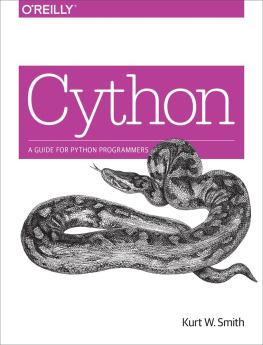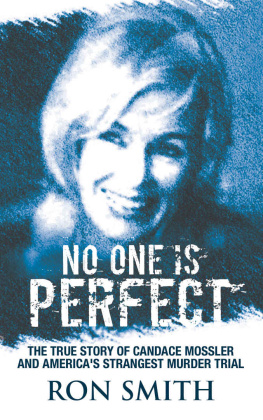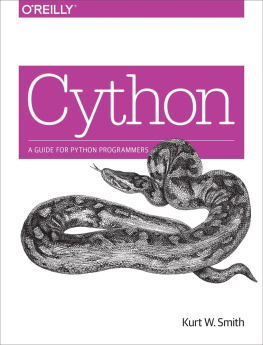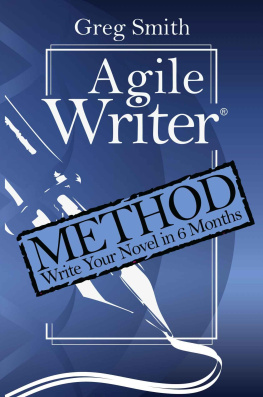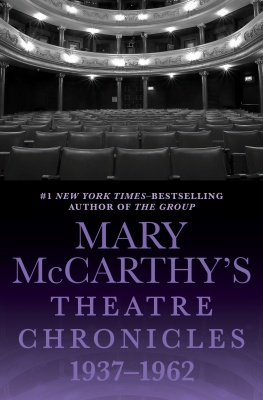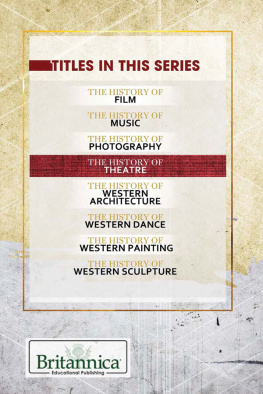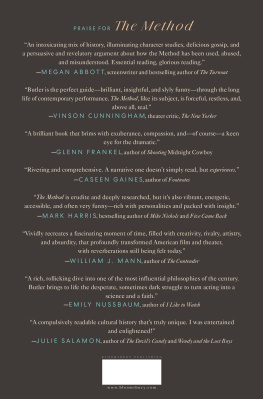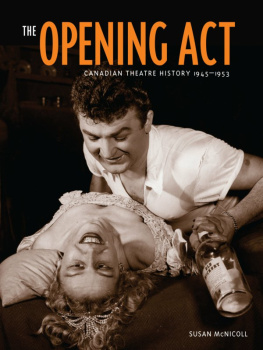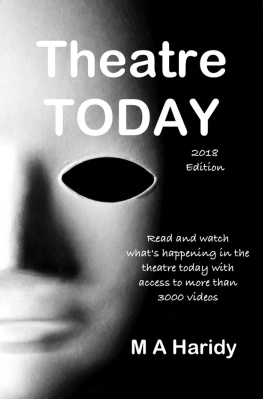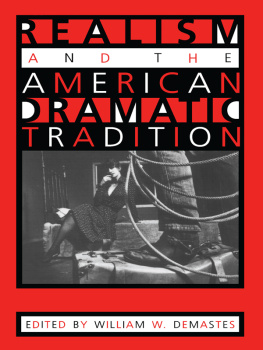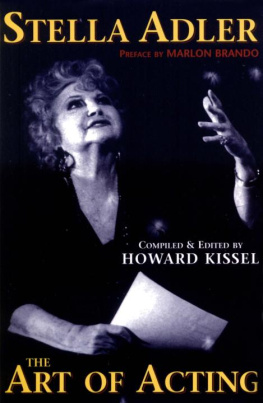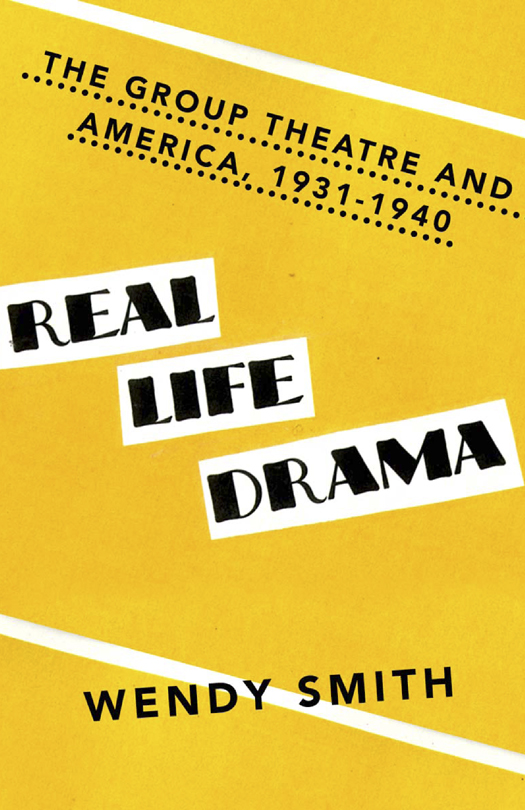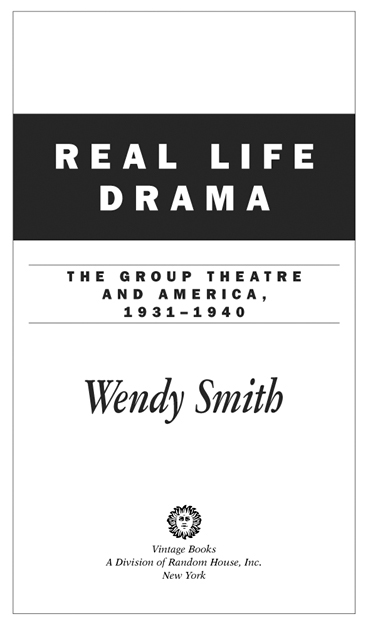Wendy Smith
REAL LIFE DRAMA
Wendy Smith is a contributing editor of The American Scholar. Her book reviews and author profiles appear in The Washington Post, The Daily Beast, Newsday, Publishers Weekly, and other publications. She has contributed articles to American Theatre magazine and is a member of the League of Professional Theatre Women and the Board of Advisers of the ReGroup Theatre.
FIRST VINTAGE BOOKS EDITION, MAY 2013
Copyright 1990 by Wendy Smith
All rights reserved. Published in the United States by Vintage Books, a division of Random House, Inc., New York, and in Canada by Random House of Canada Limited, Toronto. Originally published in hardcover in the United States by Alfred A. Knopf, a division of Random House, Inc., New York, in 1990.
Vintage and colophon are registered trademarks of Random House, Inc.
Owing to limitations of space, all acknowledgments of permission to reprint previously published material will be found following.
The Library of Congress has cataloged the Knopf edition as follows:
Smith, Wendy.
Real life drama : the Group Theatre and America, 19311940 / Wendy Smith. 1st ed.
p. cm.
Includes bibliographical references.
1. Group Theatre (U.S.) 2. TheaterUnited StatesHistory20th century.
I. Title.
[PN2297.G7S6 1990b]
792.097309043dc20
91-44170
eISBN: 978-0-307-83098-2
www.vintagebooks.com
Cover design by Najeebah Al-Ghadban
v3.1
This book is for Joe,
who got me through it
and for Alberta Magzanian,
who taught me what history is
CONTENTS
PREFACE TO THE 2013 EDITION
When Real Life Drama was first published in 1990, the Great Depression seemed very long ago and far away. Today, more than four years after the worst stock market crash since 1929, we have a more visceral understanding of the mood of fear and despair to which Harold Clurman, Lee Strasberg, and Cheryl Crawford reacted by founding the Group Theatre in 1931. Looking around them in the 1920s, they rejected that decades ephemeral affluence and unjustified complacency as spiritually and artistically unsatisfying. They dreamed of a theatre that offered more than an evenings entertainment, that grappled as honestly with modern life as Americas novelists and artists already did. They could find no one willing to finance this dream in the boom years, yet during some of the worst days of the economic bust they simply decided to make the Group Theatre happen. Twenty-five years after I began researching the Group, it still moves me to look at the photograph of thirty scruffy young people crowded onto a porch in Brookfield, Connecticut, the site of the Groups first summer retreat. They knew even then that they were giving birth to a revolution in the American theatre.
The Group believed that the theatre could change lives. They proved it in their own, creating a company that endured through a decade of financial hardship and sometimes bitter disagreements, sustained by the joy of collective creation and the thrill of finding an audience that cared as much as they did. After Real Life Drama appeared, I grew accustomed to picking up the phone and hearing the husky, ardent voices of elderly theatregoers who had tracked me down because they needed to share their memories of seeing Waiting for Lefty, or Awake and Sing! or less famous Group productions. It was the same passion I had heard when I interviewed surviving Group members and when I talked to Arthur Miller, who to the end of his life honored the Group as the source of his conviction that theatre was a public matter the ultimate tribunal in which we were to test all our beliefs. Inspiring Miller and nurturing Tennessee Williams (who won a special Group playwriting prize in 1939), the Group passed on to another generation their vision of theatre intimately intertwined with real life.
A new generation claimed the Groups legacy in 2010, when the ReGroup Theatre presented a staged reading of Success Story by John Howard Lawson. This scathing indictment of American societys sick values had launched the Groups second Broadway season in 1932, and reading it in the New York Public Library in 2010 prompted an underemployed actor named Allie Mulholland to launch a new movement by Theatre artists actively concerned with the state of the Theatre, with himself as artistic director. Alfred Kazin would have loved the coincidence: the reading room where Allie finally got his hands on Lawsons play, out of print for decades, is the same majestic public space in which Kazin spent five years researching On Native Grounds, the seminal work of literary criticism sparked in part by his delighted discovery, watching my mother and father and uncles and aunts occupying the stage in Awake and Sing! by as much right as if they were Hamlet and Lear, that American culture belonged to him too. On Native Grounds scrutinized Americas literary past as a living force in the present, part of an ongoing dialogue about issues and ideas that still define us as a nation; the ReGroup Theatre has taken a similar approach to our theatrical heritage in eleven readings and four full-scale productions of Group plays.
I was most forcibly struck by this at the ReGroups performances of 1931 and Thunder Rock, two now-obscure plays that speedily flopped when the Group first produced them. Reading them twenty-five years ago, I judged both scripts as worthy but seriously flawed and probably un-revivable outside the context in which they were written. Well, times change. The blistering account in 1931 of a proud man, sure when he loses his well-paid job that hell soon find another only to descend through successive levels of desperation to destitution and rage, didnt seem at all out of date in the ReGroups ferocious production. Nor did the final speech of Thunder Rocks protagonist, a disillusioned idealist who comes to realize that retreating into inaction is not an option in a world racked by injustice and war. Audiences at both shows were mostly young, and I could see from their emotional reactions that they did not regard these plays as historical artifacts. We are not set in dusty Masterpiece Theatre amber, Allie Mulholland declared in a recent e-mail. Its about honoring the past to move to the future. That was also my intention when I wrote Real Life Drama.
Harold Clurmanof course!said it first and probably best in the foreword to his one-sided but indispensable memoir, The Fervent Years. The Group Theatre, he wrote, was a symptom and an expression of a profound impulse in American life, an impulse that certainly did not begin with the Group Theatre, and did not end with it. What exactly was that impulse? Read on and find out. It might just change your life.
Wendy Smith
Brooklyn, New York
November 2012
PREFACE
I first encountered the Group Theatre when I was a teenager in the early 1970s. Roaming among my parents bookshelves in my perpetual quest for something to read, I stumbled on an old hardcover copy of The Fervent Years, Harold Clurmans compelling memoir of the Group. I was already fascinated by American life in the 1930s, a period that seemed to me very like the turbulent decade recently ended that had indelibly marked the way my friends and I thought about our society. I liked the photographs I saw as I thumbed through the book: young people clustered together on the porch of a frame house, looking straight at the camera with a determination in their gaze to shape the world to their vision; an intense, angry man in a shabby suit standing on a dark stage, his fists clenched in the airso that gesture hadnt been invented in the sixties! I took the book away to have a closer look.



